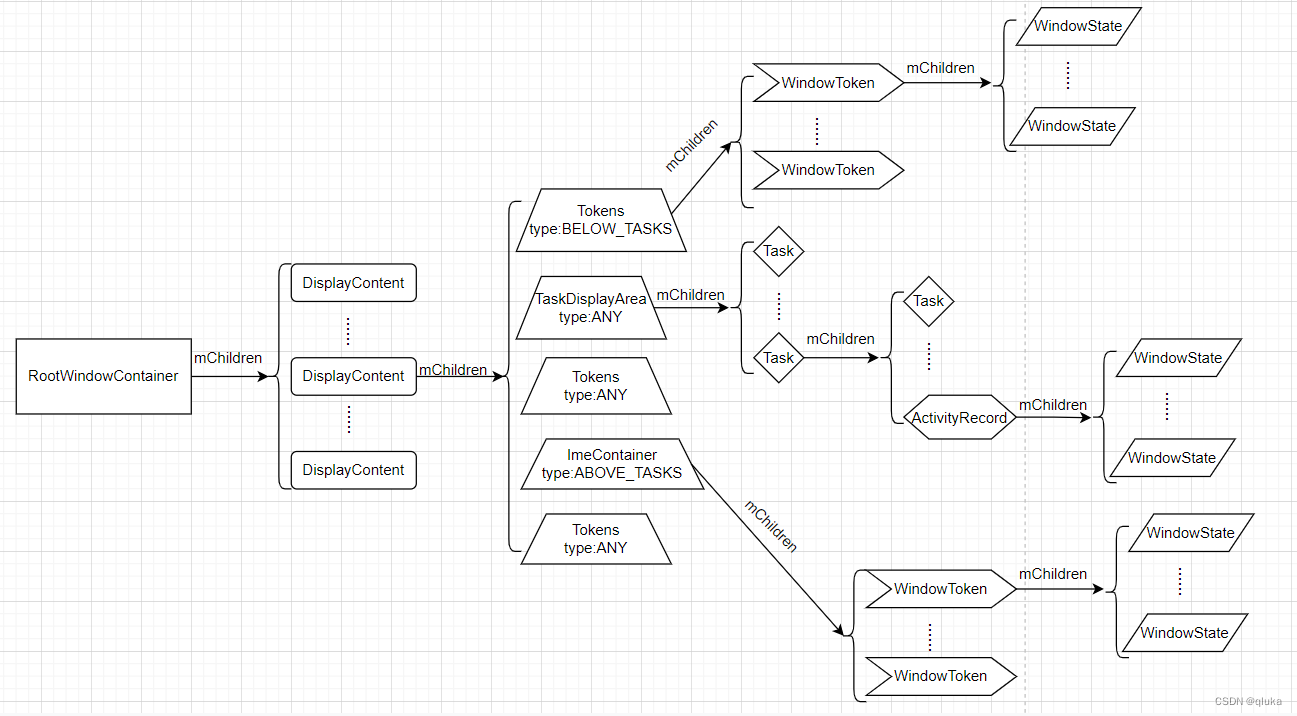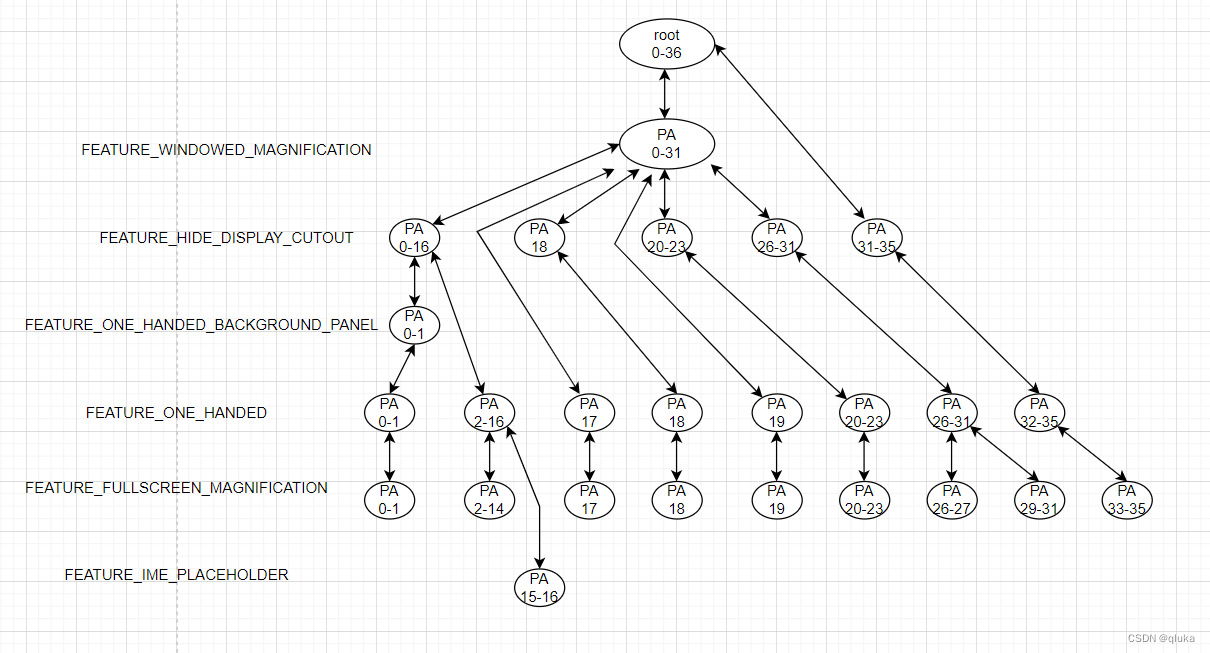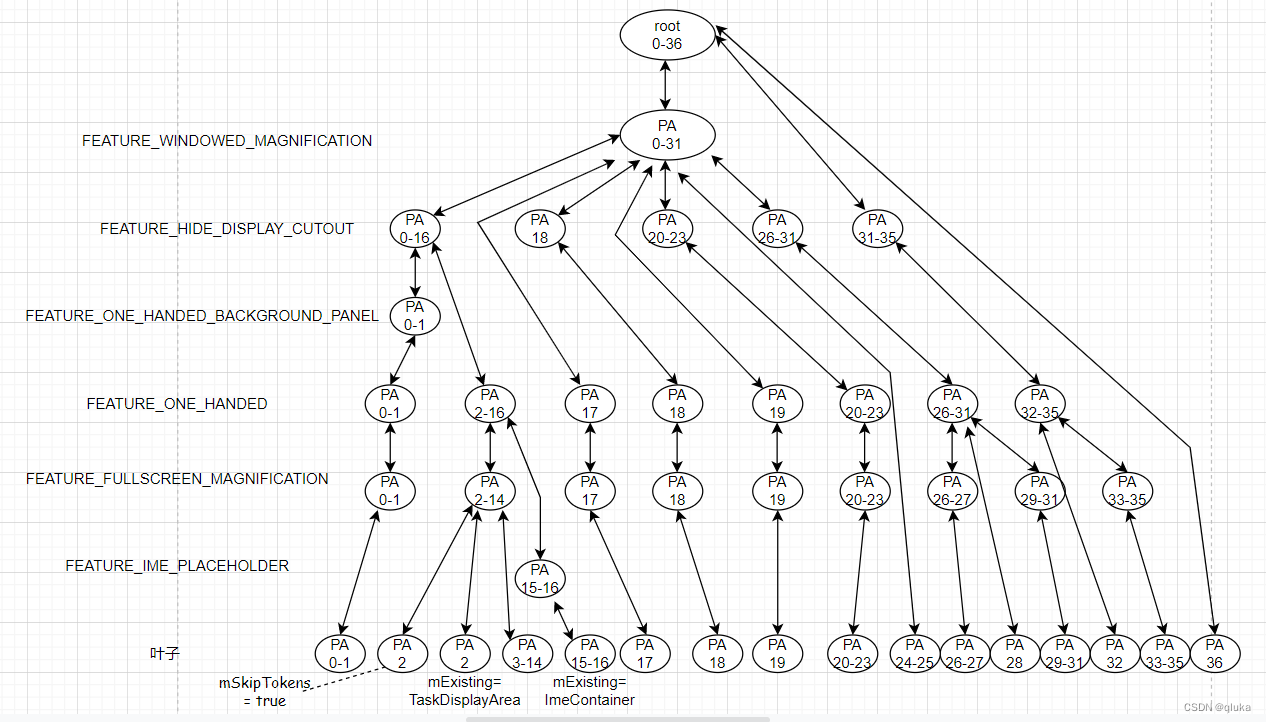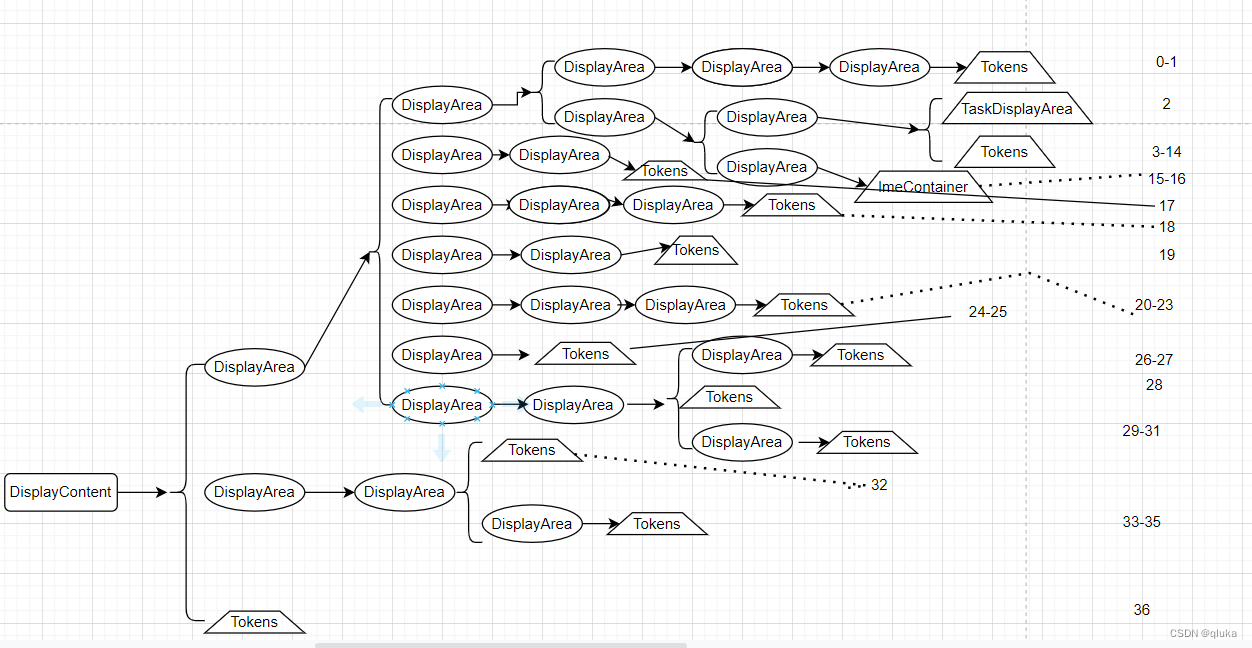- 1excel if in函数_5分钟让你学通Excel中的IF函数
- 2Hugging Face——MLM预训练掩码语言模型方法_掩码语言预训练
- 3C语言 判断是不是字母|三个数中的最大值|变种水仙花
- 4“开源 vs. 闭源:大模型的未来发展趋势预测“——探讨大模型未来的发展方向_中国 大模型 开源 闭源
- 5用iPhone前摄3D人像建模,Meta:我看行_ios 开发3d形象
- 6docker安装redis,以及常用操作
- 7本周AI热点回顾:给Deepfake 假脸做 X-Ray、飞桨助力打造肺炎筛查和预评估AI系统
- 8【C语言-二分法】二分法查找有序数组中数的下标为什么要mid+1,mid-1?_为什么二分法要left=mid+1,right=mid-1
- 9Arcgis中栅格计算器赋值python代码_栅格计算器重新赋值
- 10基于全链路的测试分析实践!
Android 窗口结构(一) 窗口层级构造_android 窗口层级
赞
踩
Android窗口是根据显示屏幕来管理,每个显示屏幕的窗口层级分为37层,0-36层。每层可以放置多个窗口,上层窗口覆盖下面的。
要理解窗口的结构,需要学习下WindowContainer、RootWindowContainer、DisplayContent、TaskDisplayArea、Task、ActivityRecord、WindowToken、WindowState
WindowContainer等类。
WindowContainer类
为直接包含窗口或者通过孩子层级形式包含窗口的类,定义了普遍功能。它作为基类被继承,像RootWindowContainer、DisplayContent、TaskDisplayArea、Task、ActivityRecord、WindowToken、WindowState都是直接或间接的继承该类。
class WindowContainer<E extends WindowContainer> extends ConfigurationContainer<E>
implements Comparable<WindowContainer>, Animatable, SurfaceFreezer.Freezable {
……
// List of children for this window container. List is in z-order as the children appear on
// screen with the top-most window container at the tail of the list.
protected final WindowList<E> mChildren = new WindowList<E>();
……
}
- 1
- 2
- 3
- 4
- 5
- 6
- 7
- 8
简单看一下类的定义,泛型参数E是继承WindowContainer,它是孩子类型。WindowList是继承ArrayList,这样就能通过mChildren ,构建一种树形结构。
窗口结构层级相关类
先上一张没添加特色模式窗口结构图:

该图是未添加特色模式时的结构图,添加特色模式之后的结构,更复杂。
RootWindowContainer:根窗口容器,树的根是它。通过它遍历寻找,可以找到窗口树上的窗口。它的孩子是DisplayContent。
DisplayContent:该类是对应着显示屏幕的,Android是支持多屏幕的,所以可能存在多个DisplayContent对象。上图只画了一个对象的结构,其他对象的结构也是和画的对象的结构是相似的。
TaskDisplayArea:它为DisplayContent的孩子,对应着窗口层次的第2层。第2层作为应用层,看它的定义:int APPLICATION_LAYER = 2,应用层的窗口是处于第2层。TaskDisplayArea的孩子是Task类,其实它的孩子类型也可以是TaskDisplayArea。而Task的孩子则可以是ActivityRecord,也可以是Task。
Tokens:它为DisplayContent的孩子,它的孩子是WindowToken。而WindowToken的孩子则为WindowState对象。WindowState是对应着一个窗口的。结构图中,DisplayContent不止包含一个Tokens,还有两个。其实ImeContainer也是继承自Tokens。
ImeContainer:它也为DisplayContent的孩子,它是输入法窗口的容器,它的孩子是WindowToken类型。WindowToken的孩子为WindowState类型,而WindowState类型则对应着输入法窗口。
Task:任务,它的孩子可以是Task,也可以是ActivityRecord类型。
ActivityRecord:是对应着应用进程中的Activity的。ActivityRecord是继承WindowToken的,它的孩子类型为WindowState。
WindowState:WindowState是对应着一个窗口的。
结构图中,DisplayContent有5个孩子。图中从上到下,第一个是Tokens,对应着窗口图层0、1。第二个是TaskDisplayArea,对应着窗口图层2。第三个是Tokens,对应着窗口图层3到14。第四个是ImeContainer,对应着窗口图层15到16。第五个是Tokens,对应着窗口图层17到36。
构建窗口结构
下面结合代码来看下上面的窗口结构的构造。
RootWindowContainer的构造是在WindowManagerService中,
private WindowManagerService(Context context, InputManagerService inputManager,
boolean showBootMsgs, boolean onlyCore, WindowManagerPolicy policy,
ActivityTaskManagerService atm, DisplayWindowSettingsProvider
displayWindowSettingsProvider, Supplier<SurfaceControl.Transaction> transactionFactory,
Supplier<Surface> surfaceFactory,
Function<SurfaceSession, SurfaceControl.Builder> surfaceControlFactory) {
……
mRoot = new RootWindowContainer(this);
……
}
- 1
- 2
- 3
- 4
- 5
- 6
- 7
- 8
- 9
- 10
可见RootWindowContainer对象作为WindowManagerService的成员变量mRoot 存在。
在ActivityTaskManagerService类中,会调用setWindowManager(WindowManagerService wm)方法,
public void setWindowManager(WindowManagerService wm) {
synchronized (mGlobalLock) {
mWindowManager = wm;
mRootWindowContainer = wm.mRoot;
mTempConfig.setToDefaults();
mTempConfig.setLocales(LocaleList.getDefault());
mConfigurationSeq = mTempConfig.seq = 1;
mRootWindowContainer.onConfigurationChanged(mTempConfig);
mLockTaskController.setWindowManager(wm);
mTaskSupervisor.setWindowManager(wm);
mRootWindowContainer.setWindowManager(wm);
}
}
- 1
- 2
- 3
- 4
- 5
- 6
- 7
- 8
- 9
- 10
- 11
- 12
- 13
ActivityTaskManagerService的成员变量mRootWindowContainer 也赋值为RootWindowContainer根对象。最后会调用RootWindowContainer的setWindowManager(wm)方法:
void setWindowManager(WindowManagerService wm) { mWindowManager = wm; mDisplayManager = mService.mContext.getSystemService(DisplayManager.class); mDisplayManager.registerDisplayListener(this, mService.mUiHandler); mDisplayManagerInternal = LocalServices.getService(DisplayManagerInternal.class); final Display[] displays = mDisplayManager.getDisplays(); for (int displayNdx = 0; displayNdx < displays.length; ++displayNdx) { final Display display = displays[displayNdx]; final DisplayContent displayContent = new DisplayContent(display, this); addChild(displayContent, POSITION_BOTTOM); if (displayContent.mDisplayId == DEFAULT_DISPLAY) { mDefaultDisplay = displayContent; } } calculateDefaultMinimalSizeOfResizeableTasks(); final TaskDisplayArea defaultTaskDisplayArea = getDefaultTaskDisplayArea(); defaultTaskDisplayArea.getOrCreateRootHomeTask(ON_TOP); positionChildAt(POSITION_TOP, defaultTaskDisplayArea.mDisplayContent, false /* includingParents */); }
- 1
- 2
- 3
- 4
- 5
- 6
- 7
- 8
- 9
- 10
- 11
- 12
- 13
- 14
- 15
- 16
- 17
- 18
- 19
- 20
- 21
- 22
从上面看出,通过屏幕管理对象mDisplayManager得到所有的显示屏幕,然后构造DisplayContent对象,再通过addChild(displayContent, POSITION_BOTTOM)方法将DisplayContent对象添加到RootWindowContainer根对象的树状结构中。
默认显示屏幕的mDisplayId 是DEFAULT_DISPLAY,看下它的值(Display类 public static final int DEFAULT_DISPLAY = 0),mDisplayId 为0作为基本显示屏幕。
接着通过getDefaultTaskDisplayArea()得到默认屏幕的TaskDisplayArea,在调用它的getOrCreateRootHomeTask(ON_TOP)创建一个根Home任务。最后把默认屏幕放在RootWindowContainer根对象的孩子的最上面。
接下来看看DisplayContent对象的构造函数。
DisplayContent对象的构造
// Contains all IME window containers. Note that the z-ordering of the IME windows will depend // on the IME target. We mainly have this container grouping so we can keep track of all the IME // window containers together and move them in-sync if/when needed. We use a subclass of // WindowContainer which is omitted from screen magnification, as the IME is never magnified. // TODO(display-area): is "no magnification" in the comment still true? private final ImeContainer mImeWindowsContainer = new ImeContainer(mWmService); /** * Create new {@link DisplayContent} instance, add itself to the root window container and * initialize direct children. * @param display May not be null. * @param root {@link RootWindowContainer} */ DisplayContent(Display display, RootWindowContainer root) { …… // Setup the policy and build the display area hierarchy. mDisplayAreaPolicy = mWmService.getDisplayAreaPolicyProvider().instantiate( mWmService, this /* content */, this /* root */, mImeWindowsContainer); …… }
- 1
- 2
- 3
- 4
- 5
- 6
- 7
- 8
- 9
- 10
- 11
- 12
- 13
- 14
- 15
- 16
- 17
- 18
- 19
这里将窗口构建的相关代码贴出来,
mWmService是WindowManagerService对象,它的getDisplayAreaPolicyProvider()得到
DisplayAreaPolicy.Provider getDisplayAreaPolicyProvider() {
return mDisplayAreaPolicyProvider;
}
- 1
- 2
- 3
mDisplayAreaPolicyProvider是WindowManagerService对象的成员变量,它初始化在WindowManagerService对象的初始化方法中:
private WindowManagerService(Context context, InputManagerService inputManager,
boolean showBootMsgs, boolean onlyCore, WindowManagerPolicy policy,
ActivityTaskManagerService atm, DisplayWindowSettingsProvider
displayWindowSettingsProvider, Supplier<SurfaceControl.Transaction> transactionFactory,
Supplier<Surface> surfaceFactory,
Function<SurfaceSession, SurfaceControl.Builder> surfaceControlFactory) {
…………
mDisplayAreaPolicyProvider = DisplayAreaPolicy.Provider.fromResources(
mContext.getResources());
…………
}
- 1
- 2
- 3
- 4
- 5
- 6
- 7
- 8
- 9
- 10
- 11
public interface Provider { ………… static Provider fromResources(Resources res) { String name = res.getString( com.android.internal.R.string.config_deviceSpecificDisplayAreaPolicyProvider); if (TextUtils.isEmpty(name)) { return new DisplayAreaPolicy.DefaultProvider(); } try { return (Provider) Class.forName(name).newInstance(); } catch (ReflectiveOperationException | ClassCastException e) { throw new IllegalStateException("Couldn't instantiate class " + name + " for config_deviceSpecificDisplayAreaPolicyProvider:" + " make sure it has a public zero-argument constructor" + " and implements DisplayAreaPolicy.Provider", e); } } }
- 1
- 2
- 3
- 4
- 5
- 6
- 7
- 8
- 9
- 10
- 11
- 12
- 13
- 14
- 15
- 16
- 17
- 18
可以看到mDisplayAreaPolicyProvider 的具体类型是可以在系统资源文件中配置的,资源字符串属性为config_deviceSpecificDisplayAreaPolicyProvider,如果为空,类型则为DefaultProvider类型。目前查看,资源文件里没有配置字符值。所以mDisplayAreaPolicyProvider类型则为DefaultProvider类型。
接着调用DefaultProvider的instantiate()方法,该方法在文件platform\frameworks\base\services\core\java\com\android\server\wm\DisplayAreaPolicy.java中
/** Provider for platform-default display area policy. */ static final class DefaultProvider implements DisplayAreaPolicy.Provider { @Override public DisplayAreaPolicy instantiate(WindowManagerService wmService, DisplayContent content, RootDisplayArea root, DisplayArea.Tokens imeContainer) { final TaskDisplayArea defaultTaskDisplayArea = new TaskDisplayArea(content, wmService, "DefaultTaskDisplayArea", FEATURE_DEFAULT_TASK_CONTAINER); final List<TaskDisplayArea> tdaList = new ArrayList<>(); tdaList.add(defaultTaskDisplayArea); // Define the features that will be supported under the root of the whole logical // display. The policy will build the DisplayArea hierarchy based on this. final HierarchyBuilder rootHierarchy = new HierarchyBuilder(root); // Set the essential containers (even if the display doesn't support IME). rootHierarchy.setImeContainer(imeContainer).setTaskDisplayAreas(tdaList); if (content.isTrusted()) { // Only trusted display can have system decorations. configureTrustedHierarchyBuilder(rootHierarchy, wmService, content); } // Instantiate the policy with the hierarchy defined above. This will create and attach // all the necessary DisplayAreas to the root. return new DisplayAreaPolicyBuilder().setRootHierarchy(rootHierarchy).build(wmService); } ………… }
- 1
- 2
- 3
- 4
- 5
- 6
- 7
- 8
- 9
- 10
- 11
- 12
- 13
- 14
- 15
- 16
- 17
- 18
- 19
- 20
- 21
- 22
- 23
- 24
- 25
- 26
- 27
首先新建一个TaskDisplayArea 对象defaultTaskDisplayArea ,看其名字叫默认TaskDisplayArea。接着创建HierarchyBuilder 对象rootHierarchy 。rootHierarchy 将imeContainer(输入法窗口容器)和刚才新建的defaultTaskDisplayArea 都设置到它的成员变量里面。
接着再判断显示屏是否是可信任的content.isTrusted(),一般系统创建的都设置为可信任的,包括默认显示屏幕。会调用configureTrustedHierarchyBuilder(rootHierarchy, wmService, content)方法进行配置,这个方法里面主要是添加一些特色模式。
最后,也是采用建造者模式新建DisplayAreaPolicyBuilder对象,然后将前面设置好的rootHierarchy对象设置到自己成员变量中,最后调用build()方法,进行建造。构造完成之后,返回的是一个Result对象,它继承DisplayAreaPolicy。所以从这里可知,DisplayContent的mDisplayAreaPolicy 是Result对象。
1、HierarchyBuilder 对象设置
static class HierarchyBuilder { …… private final RootDisplayArea mRoot; private final ArrayList<DisplayAreaPolicyBuilder.Feature> mFeatures = new ArrayList<>(); private final ArrayList<TaskDisplayArea> mTaskDisplayAreas = new ArrayList<>(); @Nullable private DisplayArea.Tokens mImeContainer; HierarchyBuilder(RootDisplayArea root) { mRoot = root; } /** Adds {@link Feature} that applies to layers under this container. */ HierarchyBuilder addFeature(DisplayAreaPolicyBuilder.Feature feature) { mFeatures.add(feature); return this; } /** * Sets {@link TaskDisplayArea} that are children of this hierarchy root. * {@link DisplayArea} group must have at least one {@link TaskDisplayArea}. */ HierarchyBuilder setTaskDisplayAreas(List<TaskDisplayArea> taskDisplayAreas) { mTaskDisplayAreas.clear(); mTaskDisplayAreas.addAll(taskDisplayAreas); return this; } /** Sets IME container as a child of this hierarchy root. */ HierarchyBuilder setImeContainer(DisplayArea.Tokens imeContainer) { mImeContainer = imeContainer; return this; } …… }
- 1
- 2
- 3
- 4
- 5
- 6
- 7
- 8
- 9
- 10
- 11
- 12
- 13
- 14
- 15
- 16
- 17
- 18
- 19
- 20
- 21
- 22
- 23
- 24
- 25
- 26
- 27
- 28
- 29
- 30
- 31
- 32
- 33
rootHierarchy.setImeContainer(imeContainer).setTaskDisplayAreas(tdaList)就是将imeContainer设置到rootHierarchy对象的成员变量mImeContainer,将tdaList添加到成员变量mTaskDisplayAreas。
2、添加特色模式
private void configureTrustedHierarchyBuilder(HierarchyBuilder rootHierarchy, WindowManagerService wmService, DisplayContent content) { // WindowedMagnification should be on the top so that there is only one surface // to be magnified. rootHierarchy.addFeature(new Feature.Builder(wmService.mPolicy, "WindowedMagnification", FEATURE_WINDOWED_MAGNIFICATION) .upTo(TYPE_ACCESSIBILITY_MAGNIFICATION_OVERLAY) .except(TYPE_ACCESSIBILITY_MAGNIFICATION_OVERLAY) // Make the DA dimmable so that the magnify window also mirrors the dim layer. .setNewDisplayAreaSupplier(DisplayArea.Dimmable::new) .build()); if (content.isDefaultDisplay) { // Only default display can have cutout. // See LocalDisplayAdapter.LocalDisplayDevice#getDisplayDeviceInfoLocked. rootHierarchy.addFeature(new Feature.Builder(wmService.mPolicy, "HideDisplayCutout", FEATURE_HIDE_DISPLAY_CUTOUT) .all() .except(TYPE_NAVIGATION_BAR, TYPE_NAVIGATION_BAR_PANEL, TYPE_STATUS_BAR, TYPE_NOTIFICATION_SHADE) .build()) .addFeature(new Feature.Builder(wmService.mPolicy, "OneHandedBackgroundPanel", FEATURE_ONE_HANDED_BACKGROUND_PANEL) .upTo(TYPE_WALLPAPER) .build()) .addFeature(new Feature.Builder(wmService.mPolicy, "OneHanded", FEATURE_ONE_HANDED) .all() .except(TYPE_NAVIGATION_BAR, TYPE_NAVIGATION_BAR_PANEL) .build()); } rootHierarchy .addFeature(new Feature.Builder(wmService.mPolicy, "FullscreenMagnification", FEATURE_FULLSCREEN_MAGNIFICATION) .all() .except(TYPE_ACCESSIBILITY_MAGNIFICATION_OVERLAY, TYPE_INPUT_METHOD, TYPE_INPUT_METHOD_DIALOG, TYPE_MAGNIFICATION_OVERLAY, TYPE_NAVIGATION_BAR, TYPE_NAVIGATION_BAR_PANEL) .build()) .addFeature(new Feature.Builder(wmService.mPolicy, "ImePlaceholder", FEATURE_IME_PLACEHOLDER) .and(TYPE_INPUT_METHOD, TYPE_INPUT_METHOD_DIALOG) .build()); }
- 1
- 2
- 3
- 4
- 5
- 6
- 7
- 8
- 9
- 10
- 11
- 12
- 13
- 14
- 15
- 16
- 17
- 18
- 19
- 20
- 21
- 22
- 23
- 24
- 25
- 26
- 27
- 28
- 29
- 30
- 31
- 32
- 33
- 34
- 35
- 36
- 37
- 38
- 39
- 40
- 41
- 42
- 43
- 44
可见,主要采用特色模式建造类Feature.Builder,设置属性,设置完成之后,添加到HierarchyBuilder 类对象rootHierarchy中。
添加的特色模式有FEATURE_WINDOWED_MAGNIFICATION、FEATURE_HIDE_DISPLAY_CUTOUT、FEATURE_ONE_HANDED_BACKGROUND_PANEL、FEATURE_ONE_HANDED、FEATURE_FULLSCREEN_MAGNIFICATION、FEATURE_IME_PLACEHOLDER。只有在屏幕是默认基础的屏幕情况下,才会添加FEATURE_HIDE_DISPLAY_CUTOUT、FEATURE_ONE_HANDED_BACKGROUND_PANEL、FEATURE_ONE_HANDED这三种。
在设置特色模式的时候,还会设置对哪些窗口图层产生影响。窗口图层和窗口类型是相关的,可以通过窗口类型得到窗口所在的图层层级。先看看特色模式建造者类:
特色模式建造者类
mName和mId是特色模式的名字和Id。
mLayers数组大小是37,对应着窗口层级。如果对应的层级设置为true,就是该模式对该窗口层级产生影响。
mNewDisplayAreaSupplier是如何新建DisplayArea,默认是DisplayArea::new。
mPolicy是和窗口类型和图层层级转化有关
mExcludeRoundedCorner是指是否排除圆角层,默认是排除的
set(int type, boolean value),layerFromType(int type, boolean internalWindows)是通过图层类型得到图层数,然后设置图层数对应的mLayers数组中的值。
特色模型类建造类中的all()、and()、except()、upTo(),他们都是为了设置对应的窗口层级。all()是所有的层级都设置为true。and()是将参数中对应的层级设置为true,except()是将参数中对应的层级设置为false,就是去除掉该层级。upTo()则是将第0层直到参数指定的层级都设置为true。
build()方法就是新建Feature对象,在其中会判断mExcludeRoundedCorner,如果为true,则将mLayers数组中对应的值设为false,目前圆角层是在最上层36层。
窗口类型和层级的转化是通过layerFromType(int type, boolean internalWindows)实现,它则是mPolicy.getWindowLayerFromTypeLw(type, internalWindows)方法实现的,mPolicy是WindowManagerPolicy类型,看下代码:
/** * Returns the layer assignment for the window type. Allows you to control how different * kinds of windows are ordered on-screen. * * @param type The type of window being assigned. * @param canAddInternalSystemWindow If the owner window associated with the type we are * evaluating can add internal system windows. I.e they have * {@link Manifest.permission#INTERNAL_SYSTEM_WINDOW}. If true, alert window * types {@link android.view.WindowManager.LayoutParams#isSystemAlertWindowType(int)} * can be assigned layers greater than the layer for * {@link android.view.WindowManager.LayoutParams#TYPE_APPLICATION_OVERLAY} Else, their * layers would be lesser. * @param roundedCornerOverlay {#code true} to indicate that the owner window is rounded corner * overlay. * @return int An arbitrary integer used to order windows, with lower numbers below higher ones. */ default int getWindowLayerFromTypeLw(int type, boolean canAddInternalSystemWindow, boolean roundedCornerOverlay) { // Always put the rounded corner layer to the top most. if (roundedCornerOverlay && canAddInternalSystemWindow) { return getMaxWindowLayer(); } if (type >= FIRST_APPLICATION_WINDOW && type <= LAST_APPLICATION_WINDOW) { return APPLICATION_LAYER; } switch (type) { case TYPE_WALLPAPER: // wallpaper is at the bottom, though the window manager may move it. return 1; case TYPE_PRESENTATION: case TYPE_PRIVATE_PRESENTATION: case TYPE_DOCK_DIVIDER: case TYPE_QS_DIALOG: case TYPE_PHONE: return 3; case TYPE_SEARCH_BAR: case TYPE_VOICE_INTERACTION_STARTING: return 4; case TYPE_VOICE_INTERACTION: // voice interaction layer is almost immediately above apps. return 5; case TYPE_INPUT_CONSUMER: return 6; case TYPE_SYSTEM_DIALOG: return 7; case TYPE_TOAST: // toasts and the plugged-in battery thing return 8; case TYPE_PRIORITY_PHONE: // SIM errors and unlock. Not sure if this really should be in a high layer. return 9; case TYPE_SYSTEM_ALERT: // like the ANR / app crashed dialogs // Type is deprecated for non-system apps. For system apps, this type should be // in a higher layer than TYPE_APPLICATION_OVERLAY. return canAddInternalSystemWindow ? 13 : 10; case TYPE_APPLICATION_OVERLAY: return 12; case TYPE_INPUT_METHOD: // on-screen keyboards and other such input method user interfaces go here. return 15; case TYPE_INPUT_METHOD_DIALOG: // on-screen keyboards and other such input method user interfaces go here. return 16; case TYPE_STATUS_BAR: return 17; case TYPE_STATUS_BAR_ADDITIONAL: return 18; case TYPE_NOTIFICATION_SHADE: return 19; case TYPE_STATUS_BAR_SUB_PANEL: return 20; case TYPE_KEYGUARD_DIALOG: return 21; case TYPE_VOLUME_OVERLAY: // the on-screen volume indicator and controller shown when the user // changes the device volume return 22; case TYPE_SYSTEM_OVERLAY: // the on-screen volume indicator and controller shown when the user // changes the device volume return canAddInternalSystemWindow ? 23 : 11; case TYPE_NAVIGATION_BAR: // the navigation bar, if available, shows atop most things return 24; case TYPE_NAVIGATION_BAR_PANEL: // some panels (e.g. search) need to show on top of the navigation bar return 25; case TYPE_SCREENSHOT: // screenshot selection layer shouldn't go above system error, but it should cover // navigation bars at the very least. return 26; case TYPE_SYSTEM_ERROR: // system-level error dialogs return canAddInternalSystemWindow ? 27 : 10; case TYPE_MAGNIFICATION_OVERLAY: // used to highlight the magnified portion of a display return 28; case TYPE_DISPLAY_OVERLAY: // used to simulate secondary display devices return 29; case TYPE_DRAG: // the drag layer: input for drag-and-drop is associated with this window, // which sits above all other focusable windows return 30; case TYPE_ACCESSIBILITY_OVERLAY: // overlay put by accessibility services to intercept user interaction return 31; case TYPE_ACCESSIBILITY_MAGNIFICATION_OVERLAY: return 32; case TYPE_SECURE_SYSTEM_OVERLAY: return 33; case TYPE_BOOT_PROGRESS: return 34; case TYPE_POINTER: // the (mouse) pointer layer return 35; default: Slog.e("WindowManager", "Unknown window type: " + type); return 3; } }
- 1
- 2
- 3
- 4
- 5
- 6
- 7
- 8
- 9
- 10
- 11
- 12
- 13
- 14
- 15
- 16
- 17
- 18
- 19
- 20
- 21
- 22
- 23
- 24
- 25
- 26
- 27
- 28
- 29
- 30
- 31
- 32
- 33
- 34
- 35
- 36
- 37
- 38
- 39
- 40
- 41
- 42
- 43
- 44
- 45
- 46
- 47
- 48
- 49
- 50
- 51
- 52
- 53
- 54
- 55
- 56
- 57
- 58
- 59
- 60
- 61
- 62
- 63
- 64
- 65
- 66
- 67
- 68
- 69
- 70
- 71
- 72
- 73
- 74
- 75
- 76
- 77
- 78
- 79
- 80
- 81
- 82
- 83
- 84
- 85
- 86
- 87
- 88
- 89
- 90
- 91
- 92
- 93
- 94
- 95
- 96
- 97
- 98
- 99
- 100
- 101
- 102
- 103
- 104
- 105
- 106
- 107
- 108
- 109
- 110
- 111
- 112
- 113
- 114
- 115
- 116
- 117
- 118
- 119
- 120
- 121
- 122
- 123
可以看到,窗口类型与图层层级对应关系。最大是getMaxWindowLayer(),它的值是36。该方法里面并没有提到0层,但是代码构造窗口层级的时候,是从0层开始的。type >= FIRST_APPLICATION_WINDOW && type <= LAST_APPLICATION_WINDOW,是APPLICATION_LAYER层,也就是第二层。FIRST_APPLICATION_WINDOW 是1,LAST_APPLICATION_WINDOW是99。在这之间的窗口类型都是属于窗口应用层。窗口层级数值越大,它就会在上面,会覆盖下层的窗口。
回到configureTrustedHierarchyBuilder()中,可以看到
| 特色模式 | 影响窗口图层 |
|---|---|
| FEATURE_WINDOWED_MAGNIFICATION | 0-31 |
| FEATURE_HIDE_DISPLAY_CUTOUT | 0-16、18、20-23、26-35 |
| FEATURE_ONE_HANDED_BACKGROUND_PANEL | 0-1 |
| FEATURE_ONE_HANDED | 0-23、26-35 |
| FEATURE_FULLSCREEN_MAGNIFICATION | 0-14、17-23、26-27、29-31、33-35 |
| FEATURE_IME_PLACEHOLDER | 15-16 |
这些影响到的图层数都是根据上面提到的几个方法里面得出来的。并且如果是默认显示屏幕,会将上述6个特色模式都加入到HierarchyBuilder对象中。
其中需要注意一点的是,在添加FEATURE_WINDOWED_MAGNIFICATION时,它是会设置建造者对象的mNewDisplayAreaSupplier 为DisplayArea.Dimmable::new。等到它构造DisplayArea对象的时候,它的实际对象类型是DisplayArea.Dimmable。它可以控制变暗的显示区域。
3 构造窗口层级
构造层级的方法在DisplayAreaPolicyBuilder类的build(WindowManagerService wmService)里面:
Result build(WindowManagerService wmService) { validate(); // Attach DA group roots to screen hierarchy before adding windows to group hierarchies. mRootHierarchyBuilder.build(mDisplayAreaGroupHierarchyBuilders); List<RootDisplayArea> displayAreaGroupRoots = new ArrayList<>( mDisplayAreaGroupHierarchyBuilders.size()); for (int i = 0; i < mDisplayAreaGroupHierarchyBuilders.size(); i++) { HierarchyBuilder hierarchyBuilder = mDisplayAreaGroupHierarchyBuilders.get(i); hierarchyBuilder.build(); displayAreaGroupRoots.add(hierarchyBuilder.mRoot); } // Use the default function if it is not specified otherwise. if (mSelectRootForWindowFunc == null) { mSelectRootForWindowFunc = new DefaultSelectRootForWindowFunction( mRootHierarchyBuilder.mRoot, displayAreaGroupRoots); } return new Result(wmService, mRootHierarchyBuilder.mRoot, displayAreaGroupRoots, mSelectRootForWindowFunc); }
- 1
- 2
- 3
- 4
- 5
- 6
- 7
- 8
- 9
- 10
- 11
- 12
- 13
- 14
- 15
- 16
- 17
- 18
- 19
- 20
这个方法主要就是调用mRootHierarchyBuilder.build(mDisplayAreaGroupHierarchyBuilders)构造层级。mDisplayAreaGroupHierarchyBuilders的大小为0,如果mSelectRootForWindowFunc 没有设置值的话,设置为DefaultSelectRootForWindowFunction对象。最后新生成一个Result对象返回。
HierarchyBuilder的build(@Nullable List displayAreaGroupHierarchyBuilders)
这里说一下,是对于默认屏幕来分析,就是设置了上面说的六种特色模式。
该方法代码挺长,分段阅读:
/**
* Builds the {@link DisplayArea} hierarchy below root. And adds the roots of those
* {@link HierarchyBuilder} as children.
*/
private void build(@Nullable List<HierarchyBuilder> displayAreaGroupHierarchyBuilders) {
final WindowManagerPolicy policy = mRoot.mWmService.mPolicy;
final int maxWindowLayerCount = policy.getMaxWindowLayer() + 1;
final DisplayArea.Tokens[] displayAreaForLayer =
new DisplayArea.Tokens[maxWindowLayerCount];
final Map<Feature, List<DisplayArea<WindowContainer>>> featureAreas =
new ArrayMap<>(mFeatures.size());
for (int i = 0; i < mFeatures.size(); i++) {
featureAreas.put(mFeatures.get(i), new ArrayList<>());
}
- 1
- 2
- 3
- 4
- 5
- 6
- 7
- 8
- 9
- 10
- 11
- 12
- 13
- 14
maxWindowLayerCount 的值为37,代表图层总数。displayAreaForLayer 数组代表每一层的叶子Tokens对象。等到下面会看到,图层结构是个树结构,它则是存储的是叶子节点的对应内容。featureAreas 里面根据特色模式。存储对应特色模式里面的窗口容器。
第二段代码:
PendingArea[] areaForLayer = new PendingArea[maxWindowLayerCount]; final PendingArea root = new PendingArea(null, 0, null); Arrays.fill(areaForLayer, root); // Create DisplayAreas to cover all defined features. final int size = mFeatures.size(); for (int i = 0; i < size; i++) { // Traverse the features with the order they are defined, so that the early defined // feature will be on the top in the hierarchy. final Feature feature = mFeatures.get(i); PendingArea featureArea = null; for (int layer = 0; layer < maxWindowLayerCount; layer++) { if (feature.mWindowLayers[layer]) { // This feature will be applied to this window layer. // // We need to find a DisplayArea for it: // We can reuse the existing one if it was created for this feature for the // previous layer AND the last feature that applied to the previous layer is // the same as the feature that applied to the current layer (so they are ok // to share the same parent DisplayArea). if (featureArea == null || featureArea.mParent != areaForLayer[layer]) { // No suitable DisplayArea: // Create a new one under the previous area (as parent) for this layer. featureArea = new PendingArea(feature, layer, areaForLayer[layer]); areaForLayer[layer].mChildren.add(featureArea); } areaForLayer[layer] = featureArea; } else { // This feature won't be applied to this window layer. If it needs to be // applied to the next layer, we will need to create a new DisplayArea for // that. featureArea = null; } } }
- 1
- 2
- 3
- 4
- 5
- 6
- 7
- 8
- 9
- 10
- 11
- 12
- 13
- 14
- 15
- 16
- 17
- 18
- 19
- 20
- 21
- 22
- 23
- 24
- 25
- 26
- 27
- 28
- 29
- 30
- 31
- 32
- 33
- 34
- 35
这里首先需要介绍下PendingArea类,它是构建窗口树的主要类。
它的mParent指向它的父PendingArea,mChildren里面是它的孩子PendingArea。mMinLayer是对应的窗口图层最小层,mMaxLayer是最大层。mExisting与mSkipTokens和createArea()相关。如果mExisting存在,就直接使用它,如果不存在,会新建DisplayArea;但是mSkipTokens为true,就不新建直接返回null。
构建的树结构是使用mParent和mChildren实现的。
现在就按照第二段代码分析一下,首先新建一个根PendingArea对象root,并且将areaForLayer数组里都填充root,这就是将各个图层的PendingArea对象都指向root。
再接着就是两层循环,第一层循环是遍历特色模式,第二层是遍历窗口图层。可以看到,在第二层循环中,如果特色模式对应的图层受影响(feature.mWindowLayers[layer]=true),并且之前没有PendingArea对象或者之前的PendingArea对象的父PendingArea和当前图层的PendingArea对象不同,会新建一个该特色模式的PendingArea对象,使它的父PendingArea指向当前图层的PendingArea对象,并且将新创建的对象添加到当前图层的PendingArea对象的mChildren里,接着将当前图层的PendingArea对象变成新生成的PendingArea对象。
这两层循环执行完毕之后,PendingArea对象树形结构如下:

// Create Tokens as leaf for every layer. PendingArea leafArea = null; int leafType = LEAF_TYPE_TOKENS; for (int layer = 0; layer < maxWindowLayerCount; layer++) { int type = typeOfLayer(policy, layer); // Check whether we can reuse the same Tokens with the previous layer. This happens // if the previous layer is the same type as the current layer AND there is no // feature that applies to only one of them. if (leafArea == null || leafArea.mParent != areaForLayer[layer] || type != leafType) { // Create a new Tokens for this layer. leafArea = new PendingArea(null /* feature */, layer, areaForLayer[layer]); areaForLayer[layer].mChildren.add(leafArea); leafType = type; if (leafType == LEAF_TYPE_TASK_CONTAINERS) { // We use the passed in TaskDisplayAreas for task container type of layer. // Skip creating Tokens even if there is no TDA. addTaskDisplayAreasToApplicationLayer(areaForLayer[layer]); addDisplayAreaGroupsToApplicationLayer(areaForLayer[layer], displayAreaGroupHierarchyBuilders); leafArea.mSkipTokens = true; } else if (leafType == LEAF_TYPE_IME_CONTAINERS) { // We use the passed in ImeContainer for ime container type of layer. // Skip creating Tokens even if there is no ime container. leafArea.mExisting = mImeContainer; leafArea.mSkipTokens = true; } } leafArea.mMaxLayer = layer; } root.computeMaxLayer();
- 1
- 2
- 3
- 4
- 5
- 6
- 7
- 8
- 9
- 10
- 11
- 12
- 13
- 14
- 15
- 16
- 17
- 18
- 19
- 20
- 21
- 22
- 23
- 24
- 25
- 26
- 27
- 28
- 29
- 30
- 31
这段代码是为窗口图层每层添加叶子PendingArea对象,每层叶子节点对象对应的类型分为三种:LEAF_TYPE_TOKENS、LEAF_TYPE_TASK_CONTAINERS、LEAF_TYPE_IME_CONTAINERS。第2层,也就是APPLICATION_LAYER层,为LEAF_TYPE_TASK_CONTAINERS;第15、16层,也就是TYPE_INPUT_METHOD、TYPE_INPUT_METHOD_DIALOG窗口类型对应的图层,为LEAF_TYPE_IME_CONTAINERS;其他的图层对应的类型为LEAF_TYPE_TOKENS。
在叶子对象为null、或者叶子对象的父PendingArea和当前图层的PendingArea对象不同、或者叶子节点不同于上次叶子的类型的时候,都会创建新的叶子对象。
叶子对象和正常的不同的是它的feature为null,叶子对象也会加入到当前图层的PendingArea对象的孩子节点中。
并且在叶子对应的图层类型为LEAF_TYPE_TASK_CONTAINERS、LEAF_TYPE_IME_CONTAINERS时,会进行特殊处理。
在为LEAF_TYPE_IME_CONTAINERS时,直接将叶子的mExisting设置为mImeContainer。mImeContainer为DisplayContent对象的成员变量mImeWindowsContainer,它是ImeContainer对象,该类继承DisplayArea.Tokens。
在为LEAF_TYPE_TASK_CONTAINERS时,会调用addTaskDisplayAreasToApplicationLayer(areaForLayer[layer])将HierarchyBuilder对象的mTaskDisplayAreas集合里的内容添加到当前图层的PendingArea对象的孩子中。
/** Adds all {@link TaskDisplayArea} to the application layer. */
private void addTaskDisplayAreasToApplicationLayer(PendingArea parentPendingArea) {
final int count = mTaskDisplayAreas.size();
for (int i = 0; i < count; i++) {
PendingArea leafArea =
new PendingArea(null /* feature */, APPLICATION_LAYER, parentPendingArea);
leafArea.mExisting = mTaskDisplayAreas.get(i);
leafArea.mMaxLayer = APPLICATION_LAYER;
parentPendingArea.mChildren.add(leafArea);
}
}
- 1
- 2
- 3
- 4
- 5
- 6
- 7
- 8
- 9
- 10
- 11
可见也是将mTaskDisplayAreas中的对象设置为新创建PendingArea 对象的成员变量mExisting 。mTaskDisplayAreas中的对象,是我们前面说的默认TaskDisplayArea对象defaultTaskDisplayArea,最后将该 新创建PendingArea 对象添加到当前图层对应的PendingArea 对象的孩子中。
经过这第三段的代码的循环之后,上面的PendingArea对象树形结构图就编程如下:

// We built a tree of PendingAreas above with all the necessary info to represent the
// hierarchy, now create and attach real DisplayAreas to the root.
root.instantiateChildren(mRoot, displayAreaForLayer, 0, featureAreas);
- 1
- 2
- 3
PendingArea对象树形结构构建完成,现在调用树根root的instantiateChildren()方法,来构建窗口层级图,其中mRoot是DisplayContent对象,displayAreaForLayer是每层的DisplayArea对象,featureAreas是每个特色模式里面所有的非叶子节点生成的DisplayArea对象,displayAreaForLayer和featureAreas里的值都是在方法中生成的,继续看PendingArea的instantiateChildren():
void instantiateChildren(DisplayArea<DisplayArea> parent, DisplayArea.Tokens[] areaForLayer, int level, Map<Feature, List<DisplayArea<WindowContainer>>> areas) { mChildren.sort(Comparator.comparingInt(pendingArea -> pendingArea.mMinLayer)); for (int i = 0; i < mChildren.size(); i++) { final PendingArea child = mChildren.get(i); final DisplayArea area = child.createArea(parent, areaForLayer); if (area == null) { // TaskDisplayArea and ImeContainer can be set at different hierarchy, so it can // be null. continue; } parent.addChild(area, WindowContainer.POSITION_TOP); if (child.mFeature != null) { areas.get(child.mFeature).add(area); } child.instantiateChildren(area, areaForLayer, level + 1, areas); } }
- 1
- 2
- 3
- 4
- 5
- 6
- 7
- 8
- 9
- 10
- 11
- 12
- 13
- 14
- 15
- 16
- 17
- 18
首先会将孩子按照mMinLayer的值进行升序排列。然后调用孩子的createArea()生成DisplayArea对象。如果该节点生成的DisplayArea对象为null,就继续执行下一个孩子节点的循环操作。如果生成了DisplayArea对象,会将该对象加入到parent的孩子中的最上面,我们知道parent目前是DisplayContent对象。接着会判断孩子的mFeature对象不为null,就添加到参数areas中。我们知道,节点是叶子的时候,它的mFeature 才会为null。所以这个是筛掉叶子节点。接着就是递归调用孩子的instantiateChildren()。不过这次传入的parent参数,是孩子刚才生成的DisplayArea对象。
继续看下createArea()方法:
@Nullable private DisplayArea createArea(DisplayArea<DisplayArea> parent, DisplayArea.Tokens[] areaForLayer) { if (mExisting != null) { if (mExisting.asTokens() != null) { // Store the WindowToken container for layers fillAreaForLayers(mExisting.asTokens(), areaForLayer); } return mExisting; } if (mSkipTokens) { return null; } DisplayArea.Type type; if (mMinLayer > APPLICATION_LAYER) { type = DisplayArea.Type.ABOVE_TASKS; } else if (mMaxLayer < APPLICATION_LAYER) { type = DisplayArea.Type.BELOW_TASKS; } else { type = DisplayArea.Type.ANY; } if (mFeature == null) { final DisplayArea.Tokens leaf = new DisplayArea.Tokens(parent.mWmService, type, "Leaf:" + mMinLayer + ":" + mMaxLayer); fillAreaForLayers(leaf, areaForLayer); return leaf; } else { return mFeature.mNewDisplayAreaSupplier.create(parent.mWmService, type, mFeature.mName + ":" + mMinLayer + ":" + mMaxLayer, mFeature.mId); } }
- 1
- 2
- 3
- 4
- 5
- 6
- 7
- 8
- 9
- 10
- 11
- 12
- 13
- 14
- 15
- 16
- 17
- 18
- 19
- 20
- 21
- 22
- 23
- 24
- 25
- 26
- 27
- 28
- 29
- 30
- 31
在这里,我们能看到PendingArea类的mExisting 和mSkipTokens属性的使用。如果mExisting 存在直接就返回它,不会重新生成新的。
如果mExisting 不存在,并且mSkipTokens= true,这个时候,会返回null。
如果mExisting 不存在,并且mSkipTokens= false,则会新生成DisplayArea对象。新生成的DisplayArea对象,如果mFeature 为null,则为DisplayArea.Tokens对象。不然,则会调用mFeature.mNewDisplayAreaSupplier的create()方法生成具体的对象。我们知道,在前面添加特色模式时,会将mFeature.mNewDisplayAreaSupplier设置为DisplayArea.Dimmable::new。如果不设置mFeature.mNewDisplayAreaSupplier,它默认为DisplayArea::new。
我们还看到,新生成的DisplayArea对象的type,是根据PendingArea类的mMinLayer 和mMaxLayer 来决定。
如果新生成的DisplayArea对象是Tokens 类型,会填充参数areaForLayer数组,将对应层级的Tokens对象放入其中。
这第四段代码执行完毕,之后,窗口层级结构就完成了,如下

结合前面说的窗口层级结构的根对象,是RootWindowContainer对象。如果要补全多屏幕的窗口层级结构,还要分析其他屏幕的构造,不过是比默认屏幕少好几个特色模式的,要比默认屏幕的结构要简单一些。
前面在提到RootWindowContainer的setWindowManager(WindowManagerService wm)方法时,是说屏幕构造函数完成之后,会创建HomeTask,创建HomeTask的内容,放到下一篇文章里面介绍。



